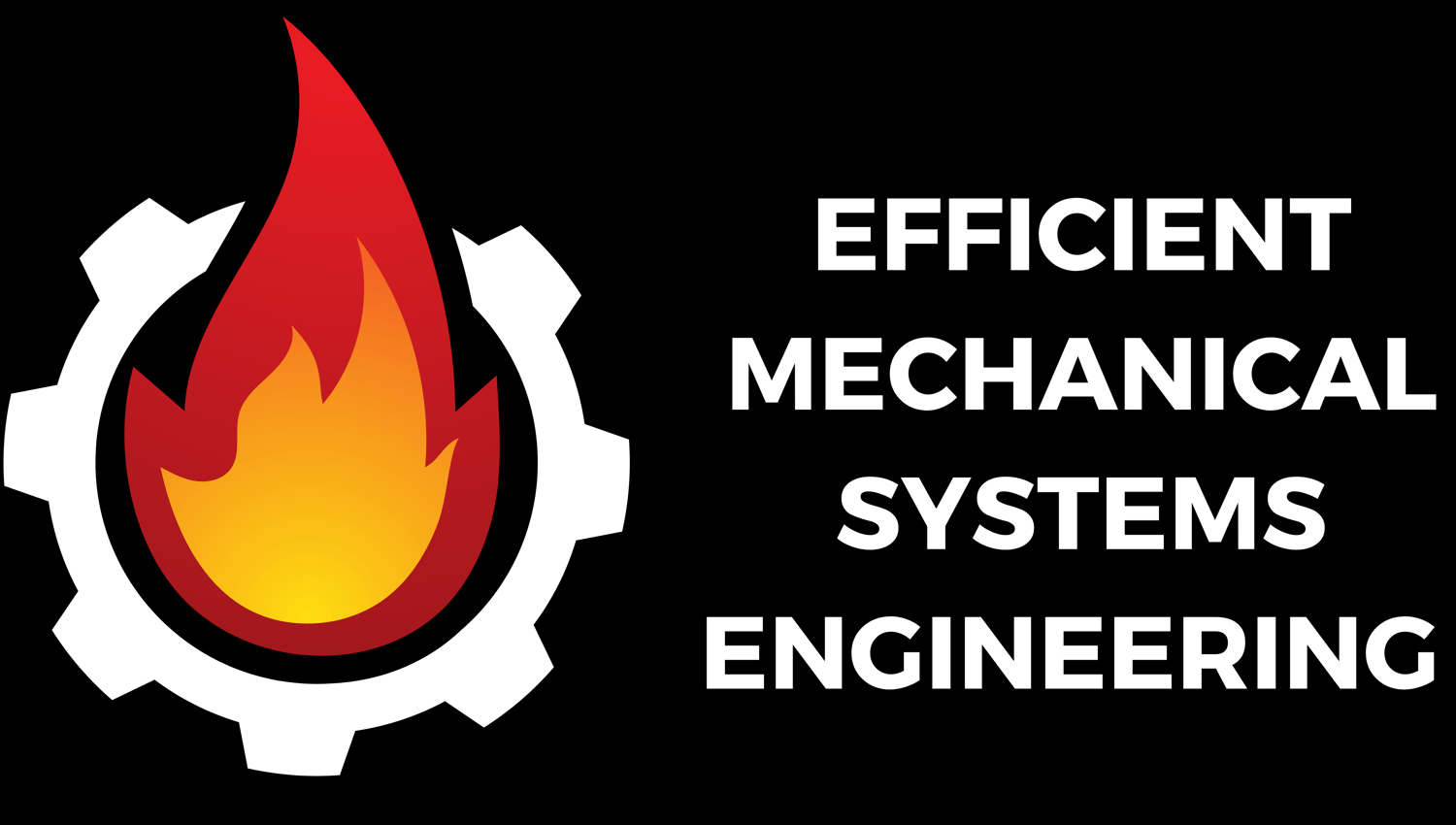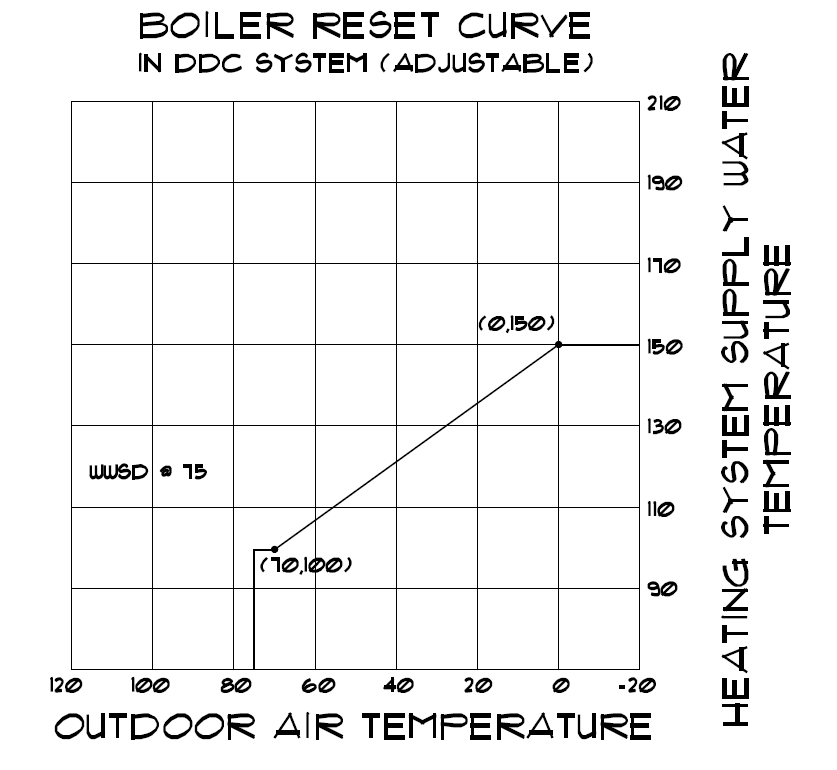When designing and installing hydronic heating systems for residential or commercial properties, outdoor reset and warm weather shutdown are control strategies that I implement to optimize energy efficiency, improve comfort, and extend the life of the mechanical equipment. Outdoor reset is when the control system automatically adjusts the supply water temperature based on the outdoor temperature. Warm weather shut down is the point where the control automatically turns off the boiler or heating equipment. These strategies reduce energy consumption and improve the overall system performance. I have effectively used these strategies on boilers and water to water heat pumps.
Outdoor Reset: Outdoor reset control is when a control system (be it an onboard equipment controller, DDC controller, or other controller) measures the outdoor air temperature using a thermistor and then calculates the desired supply water temperature based on program settings within the controller. The idea behind it is that on a cooler day the system increases the supply water temperature, and on a warmer day the controller reduces the supply water temperature. For example, on a radiant heating system, the controller may be programmed to deliver 140°F water when it is 0°F outside; and then when it is warm the controller may be set to deliver 85°F water when it is 65°F outside. Implementing outdoor reset control saves energy and it also makes the heating system more comfortable as it reduces the amount of overheating that occurs on warm days.
Warm Weather Shut Down: Another energy efficient control strategy that is often implemented in conjunction with outdoor reset is warm weather shut down. Warm weather shut down is an outdoor air temperature that is programmed into the controller where the control system will not respond to a heating call and will automatically shut down the boiler, heat pump, pumps, and other devices. Typically, the warm weather shut down point is programmed to 65°F to 70°F, but it should be reviewed with the clients or tenants of the building. A warm weather shut down dead band is also programmed into the control of typically 5°F. This requires the outdoor air temperature to drop this many degrees below the warm weather shut down point before it will resume operation.
Boilers: Outdoor reset on a boiler system reduces energy consumption by varying the supply water temperature. In a traditional single temperature system the water temperature may be set to a fixed temperature that is determined by the heating load of the building for the coldest day of the year. However, this temperature is not the most efficient or comfortable as it will be too high on warmer days. When outdoor reset is applied on a condensing high efficient boiler system, the efficiency of the system can be maximized. At the upper end of a reset curve, the boiler may not be condensing but at lower outside air temperatures the boiler can be set to run at a much lower supply water temperature and be in the full condensing mode to achieve the greatest efficiency levels. When implementing outdoor reset on baseboard heating systems with a condensing boiler, I will often run the outdoor reset curve with a supply water of 180°F at 10°F outside down to a supply water of 130°F at an outside temperature of 70°F. For a radiant heating system with a condensing boiler, I will run the outdoor reset curve with a supply water temperature of 130°F to 145°F at 10°F outside down to a supply water of 85°F at an outside temperature of 70°F. On both of these systems the maximum supply water temperature has been determined through the heat loss calculations and the maximum output of the baseboard or radiant floor at the design conditions. These maximum temps can also vary depending on the amount of baseboard or radiant tubing utilized. For example, a radiant floor with tubing on 6” centers will require a lower temperature supply water than a radiant floor with tubing on 12” centers.
Water to Water Heat Pumps: I have found that when using water to water heat pumps for a radiant heating system that the heat pump does not have to work nearly as hard if outdoor reset is implemented. This makes the system more comfortable and more efficient, while also extending the life of the heat pump. Outdoor reset is typically implemented using an outdoor reset controller such as a Tekmar, Heat Timer, HBX, or similar type controller. In some cases, the heat pump itself may have its own on-board controller. The idea being that a temperature sensor is located in the buffer tank and an outside air temperature is located outside. The outdoor reset curve is set to supply 120°F to 125°F water for the design low temperature and 80°F to 85°F when the temperature is mild outside. By varying these supply water temperatures, it greatly reduces the stress on the heat pump and extends its operating life.
How Much Energy can be Saved? When outdoor reset and warm weather shut down are implemented on a system that has not previously utilized these strategies, it will save the customer energy and in turn lower their operating costs. In addition, it is a sustainable control strategy as it will extend the operating life of their equipment.
When providing energy savings estimates to a client before the project has begun, I typically try to err on the conservative side. I typically calculate that outdoor reset will provide a 5% energy savings and that warm weather shutdown will often provide another 5%. This is not taking into account any energy savings that may be gained for going to a high efficient condensing boiler. So if the boiler is being changed out at that time, it is also important to add the efficiency improvement of the boiler which will typically be 10% to 20%. As a result, on a high efficient boiler change out where I will implement outdoor reset and warm weather shutdown, the total estimated energy savings that I tell the customer they may expect is between 20% and 30%. In my experience, these have been fairly conservative estimates and on many projects the customer has experienced energy savings of 35% or higher.
Summary: In summary, outdoor reset and warm weather shut down are energy savings control strategies that should be implemented to maximize energy savings. Outdoor reset is when the supply water temperature is varied depending on the outside air temperature. Warm weather shut down is the point at which the control will automatically shut down the heating system when the outside air temperature rises above a preset setting. Each one of these strategies can lead to energy reductions of 5% or higher and when these strategies are combined with a high efficient boiler upgrade it is common to realize energy savings of 20% to 30% or even higher.
If you require help with energy efficient control strategies orr you are interested in mentoring/coaching for engineers, please reach out to Efficient Mechanical Engineering Systems. Thank you, and remember, “Sustainability starts with Responsible Design.”



Comments ()